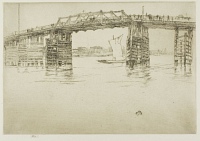Etchings Institutions search term: grolier club
Old Battersea Bridge | ||
| Number: | 188 | |
| Date: | 1879 | |
| Medium: | etching and drypoint | |
| Size: | 202 x 293 mm | |
| Signed: | butterfly at lower right (2-6); replaced with new butterfly (6); replaced again (7) | |
| Inscribed: | no | |
| Set/Publication: | Fine Art Society, 1879 | |
| No. of States: | 7 | |
| Known impressions: | 40 | |
| Catalogues: | K.177; M.174; W.141 | |
| Impressions taken from this plate (40) | ||
STATE
Seven states are known before cancellation.
State 1

There is no signature or inscription.
The composition is basically complete; to the left of the sail, there is an unshaded space at the base of three houses; houses show very faintly through the sail, and there are minimal reflections under the pier at far right.
The impression reproduced is the unique impression of the first state, which Whistler called a 'Trial' rather than a state - it is signed in graphite pencil with a butterfly and inscribed 'Trial rub - Cheap! - Aug 3 - 1879.' It is only partly inked, and has additions in graphite pencil at the base of the two piers at right; it has a printer's crease at left and abraded areas.
State 2

Signed with a faint butterfly at lower right.
The houses still show faintly through the sail; the outline of the base of the pier at far right is completed and the reflections extended.
State 4

Drypoint additions include fine, short vertical lines at the base of the houses on the far bank; short slanting lines across the transverse beams of the right arch; clouds above and through the bridge, lightly outlined and slightly shaded.
State 5

More close, light shading is added to the clouds seen between the three right spans of the bridge.
State 6

The butterfly has been erased, and a smaller one etched in, further to the left.
The drypoint lines of shading on the houses and the short slanting lines on the transverse beams are worn, and there are three prominent, nearly vertical scratches running from the two central piers and from the central span through the water beneath them; there is also an 'x'-shaped scratch to the left of the central scratch.
This state marks the revision of the plate by Whistler in 1887/1888; the scratches may indicate his intention to cancel the plate, but instead it was repaired and reprinted.





